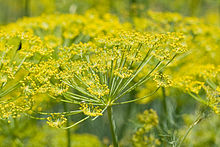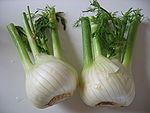 |
|
|
|
|
| Cuisines | Herbal | Spice | Curry | Yeast | Recipe | ||||||
|
Fennel Fennel (Foeniculum vulgare) is a plant species in the genus Foeniculum (treated as the sole species in the genus by most botanists). It is a member of the family Apiaceae (formerly the Umbelliferae). It is a hardy, perennial, umbelliferous herb, with yellow flowers and feathery leaves. It is indigenous to the shores of the Mediterranean, but has become widely naturalised in many parts of the world, especially on dry soils near the sea-coast and on riverbanks. It is a highly aromatic and flavorful herb with culinary and medicinal uses, and, along with the similar-tasting anise, is one of the primary ingredients of absinthe. Florence fennel or finocchio is a selection with a swollen, bulb-like stem base that is used as a vegetable. Fennel is used as a food plant by the larvae of some Lepidoptera species including the mouse moth and the anise swallowtail. Appearance Fennel, Foeniculum vulgare, is a perennial herb. It is erect, glaucous green, and grows to heights of up to 2.5 m, with hollow stems. The leaves grow up to 40 cm long; they are finely dissected, with the ultimate segments filiform (threadlike), about 0.5 mm wide. (Its leaves are similar to those of dill, but thinner.) The flowers are produced in terminal compound umbels 5–15 cm wide, each umbel section having 20–50 tiny yellow flowers on short pedicels. The fruit is a dry seed from 4–10 mm long, half as wide or less, and grooved. Cultivation and usesFennel is widely cultivated, both in its native range and elsewhere, for its edible, strongly flavoured leaves and fruits. Its aniseed flavour comes from anethole, an aromatic compound also found in anise and star anise, and its taste and aroma are similar to theirs, though usually not as strong.  The Florence fennel (Foeniculum vulgare Azoricum Group; syn. F. vulgare var. azoricum) is a cultivar group with inflated leaf bases which form a bulb-like structure. It is of cultivated origin, and has a mild anise-like flavour, but is more aromatic and sweeter. Florence fennel plants are smaller than the wild type. Their inflated leaf bases are eaten as a vegetable, both raw and cooked. There are several cultivars of Florence fennel, which is also known by several other names, notably the Italian name finocchio. In North American supermarkets, it is often mislabelled as "anise". Foeniculum vulgare 'Purpureum' or 'Nigra', "bronze-leaved" fennel, is widely available as a decorative garden plant. Fennel has become naturalised along roadsides, in pastures, and in other open sites in many regions, including northern Europe, the United States, southern Canada and in much of Asia and Australia. It propagates well by seed, and is considered an invasive species and a weed in Australia and the United States. In western North America, fennel can be found from the coastal and inland wildland-urban interface east into hill and mountain areas, excluding desert habitats. Florence fennel was one of the three main herbs used in the preparation of absinthe, an alcoholic mixture which originated as a medicinal elixir in Switzerland and became, by the late 19th century, a popular alcoholic drink in France and other countries. Culinary usesThe bulb, foliage, and seeds of the fennel plant are widely used in many of the culinary traditions of the world. Fennel pollen is the most potent form of fennel, but also the most expensive. Dried fennel seed is an aromatic, anise-flavoured spice, brown or green in colour when fresh, slowly turning a dull grey as the seed ages. For cooking, green seeds are optimal. The leaves are delicately flavoured and similar in shape to those of dill. The bulb is a crisp vegetable that can be sautéed, stewed, braised, grilled, or eaten raw. Fennel seeds are sometimes confused with those of anise, which are similar in taste and appearance, though smaller. Fennel is also used as a flavouring in some natural toothpastes. Fennel features prominently in Mediterranean cuisine, where bulbs and fronds are used, both raw and cooked, in side dishes, salads, pastas, vegetable dishes and risottos. Fennel seed is a common ingredient in Italian sausages and meatballs and northern European rye breads. Many cultures in India, Pakistan, Afghanistan, Iran and the Middle East use fennel seed in their cookery. Fennel is one of the most important spices in Kashmiri Pandit and Gujarati cooking. It is an essential ingredient of the Assamese/Bengali/Oriya spice mixture panch phoron and in Chinese five-spice powders. In many parts of India and Pakistan, roasted fennel seeds are consumed as mukhwas, an after-meal digestive and breath freshener. Fennel leaves are used as leafy green vegetables either by themselves or mixed with other vegetables, cooked to be served and consumed as part of a meal, in some parts of India. In Lebanon, it is used to make a special kind of egg omelette (along with onions, and flour) called ijjeh. Many egg, fish, and other dishes employ fresh or dried fennel leaves. Florence fennel is a key ingredient in some Italian and German salads, often tossed with chicory and avocado, or it can be braised and served as a warm side dish. It may be blanched or marinated, or cooked in risotto. Medicinal usesFennel contains anethole, which can explain some of its medical effects:[citation needed] it, or its polymers, act as phytoestrogens. Carminative properties of fennel are known from ancient times, as recorded in the Latin phrase "semen foeniculi pellit spiracula culi", which literally means "the fennel seeds make blow the arsehole". Fennel can be made into a syrup to treat babies with colic (formerly thought to be due to digestive upset), but long term ingestion of fennel preparations by babies is a known cause of thelarche. For adults, fennel seeds or tea can relax the intestines and reduce bloating caused by digestive disorders EyesIn the Indian subcontinent, fennel seeds are also eaten raw, sometimes with some sweetener, as they are said to improve eyesight. Ancient Romans regarded fennel as the herb of sight. Root extracts were often used in tonics to clear cloudy eyes. Extracts of fennel seed have been shown in animal studies to have a potential use in the treatment of glaucoma. Blood and urineFennel may be an effective diuretic and a potential drug for treatment of hypertension. BreastmilkThere are historical anecdotes that fennel is a galactagogue, improving the milk supply of a breastfeeding mother. This use, although not supported by direct evidence, is sometimes justified by the fact that fennel is a source of phytoestrogens, which promote growth of breast tissue. However, normal lactation does not involve growth of breast tissue. A single case report of fennel tea ingested by a breastfeeding mother resulted in neurotoxicity for the newborn child. Other usesSyrup prepared from fennel juice was formerly given for chronic coughs. It is one of the plants which is said to be disliked by fleas, and powdered fennel has the effect of driving away fleas from kennels and stables. |











